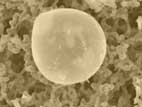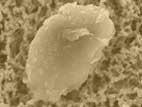Click here to learn more about the TOMS Satellite
Microbes Ride the Dust
NASA-funded researchers have
discovered that bacteria and fungi are being transported in
plumes of North African dust that cross the Atlantic Ocean and
arrive in the Americas and the Caribbean. Dust storms and the
rising warm air can lift dust 10,000 feet or so above the
African deserts and then out across the Atlantic, many times
reaching as far as the Caribbean where they often require the
local weather services to issue air pollution alerts. Recent
studies have linked disease born illnesses and the decline of
the coral reefs in the Caribbean to the increasing frequency
and intensity of Saharan dust events.
DUST PARTICLE LANDSCAPE - Microbes transported by dust
storms in North Africa have been hitching rides across the
Atlantic--living in the highly irregular nooks and crannies
found in the surfaces of dust particles. These images were
taken by an electron microscope magnified 12,000 & 8,000
times. Notice the moon-like craters which protect the microbes
from exposure to ultraviolet radiation from the Sun.
Scientists also think that upper altitudes of the dust clouds
deflect harmful UV rays, shielding microbes at lower altitudes
as they are transported across the Atlantic Ocean.
Additionally, when dust clouds move over
open water in lower latitudes, the moderate temperatures and
high humidity are known to enhance microbial survival.

Dust Image Magnified 12,000 Times

Dust Image Magnified 8,000 Times
Images Courtesy: USGS
ITEM 2) MICROBES RIDE THE DUST ANIMATION -The dust comes every year during northern Africa's dry season, when storm activity in the Sahara Desert and Sahel generate clouds of dust. The dust originating from fine particles in the arid topsoil is transported into the atmosphere by winds and may be carried in excess of 10,000 feet high into the atmosphere by easterly trade winds. Typically, it takes 5 to 7 days for the dust clouds to cross the Atlantic Ocean and reach the Caribbean and Americas. This animation illustrates microbes hitching rides across the Atlantic in the highly irregular nooks and crannies found in the surfaces of dust particles and how they are transported across the Atlantic Ocean.
Animation Courtesy: NASA
TOMS DATA VISUALIZATIONS - During the peak of the 2000 dust season, scientists collected samples of airborne pollutants and dust daily on the island of St. John in the Virgin Islands. The results show that high levels of microbes were collected on the days that NASA's Total Ozone Mapping Spectrometer (TOMS) satellite instrument observed the African dust sweeping into the region, indicating that the microbes had been transported from Africa. The TOMS data were rendered and combined with a world map to help scientists track the progress of the clouds of dust. The tan and orange colors in these images primarily show high concentrations of dust. Some aerosols from biomass burning can also be seen.
This animation shows TOMS July 2000 Aerosol Index.
This animation has TOMS May - June 14,1983 Aerosol Index (dustiest year on record).
Images Courtesy: NASA
DUST IMAGES FROM AROUND THE WORLD - The Sea-viewing Wide Field-of-view Sensor (SeaWiFS) on board the Orb View-2 Satellite, has captured images of dust storms around the globe. According to the recent studies, high dust frequency is not necessarily a result of the decreased rainfall, but rather its cause.
Off the northwestern coast of the African Continent, February, 26th 2000 this animation shows a dust storm the size of Spain.
Image Courtesy: NASA/Orbimage NOTE: All SeaWiFS images and data presented on this web site are for research and educational use only. All commercial use of SeaWiFS data must be coordinated with GeoEye (Orbimage became GeoEye and then In January 2013, DigitalGlobe and GeoEye combined to become one DigitalGlobe.).
AIR SAMPLING B-ROLL - Dr. Virginia Garrison, USGS, collects samples of airborne pollutants and dust daily on the island of St. John in the Virgin Islands. The samples are then sent to the USGS laboratory in St. Petersburg, Florida, for microbial analysis.
Animation Courtesy: Murphy Entertainment Group
CULTURING ORGANISMS B-ROLL - Fungi and bacteria that survive the trans-Atlantic journey in dust include bacterial or fungal cultures that do not produce disease mixed with species that do produce disease in both humans and plants. A fungus, which has been isolated in African dust, Aspergillus sydowii, has been determined to cause Sea Fan disease in coral reefs throughout the Caribbean. Desert dust exposure has also been identified as a source of terrestrial disease outbreaks including: Aspergillosis in animals, and Coccidioidomycosis. B-roll of Drs. Dale Griffin & Christina Kellogg culturing samples from St. John in lab.
Animation Courtesy: Murphy Entertainment Group
For more information contact: Deanna Kekesi, Associate NASA-TV Producer, deanna.l.kekesi@nasa.gov, Tel. 1-301-286-0041. Last Updated 06/13/01